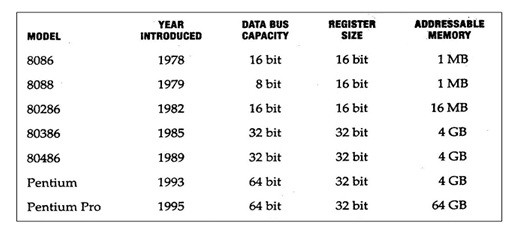The Intel Processors :
The Intel Corporation is the biggest manufacturer of microchips in the world, in addition to being the leading provider of chips for PCs. In actual fact, Intel invented the microprocessor, the so-called "computer on a chip," in the year 1971 with the 4004 model It was this invention that led to the first microcomputers that began appearing in the year 1975. However, Intel's success in this market was not guaranteed till 198l, when IBM released the first IBM PC, which was based on the Intel 8088. Since then all IBM machines and the compatibles based on IBM's design have been created on Intel's chips. A list of those chips, along with their basic specifications, is denoted in Table 1.4. Although the 80>SS was the first chip to be used in an IBM PC IBM really used an earlier chip, the 808(1, in a subsequent model, called the IBM PC XT. The chips that came later-the 286, 386, 486, and even the Pentium-I-correspond.
To sure design standards that were established by the 8086. This line of chips frequently referred to as the 80×86 line.
The steady increase in register size, bus size and addressable memory illustrated in Table 1.4 has also been accompanied by increases in clock speed. i.e., the clock attached to the first PCs ran at 4.77 MHz. whereas clock speeds for Pentium chips started at 60 MHz in the year 1993 and quickly rise to 100, 120, and 133,150, and 166 MHz.

It is essential to realize that these statistics do not convey all the improvements that have been made. The basic design of every chip, known as the architecture, has raised steadily in complexity and sophistication. i.e., the architecture of the 386 contained 320,000 transistors, ANCI the 486 have 1.2 million. With the Pentium, that number rose to more than 3.1 million, and the Pentium Pro's architecture brought the total number of transistors on tile chip to 5.5 million. The growing complication of the architecture allowed Intel to incorporate some sophisticated techniques for procedure. One main improvement that came with the 386 is known virtual 8086 mode. In this mode, a single 386 chip could gain the processing power of 16 separate 8086 chips each running a separate copy of the operating system. It is like capability for virtual 8086 mode enabled a single 386 chip to run different type of programs at the same time, a technique known as multitasking. Every chip that succeeded the 386 has had the capacity for multitasking.